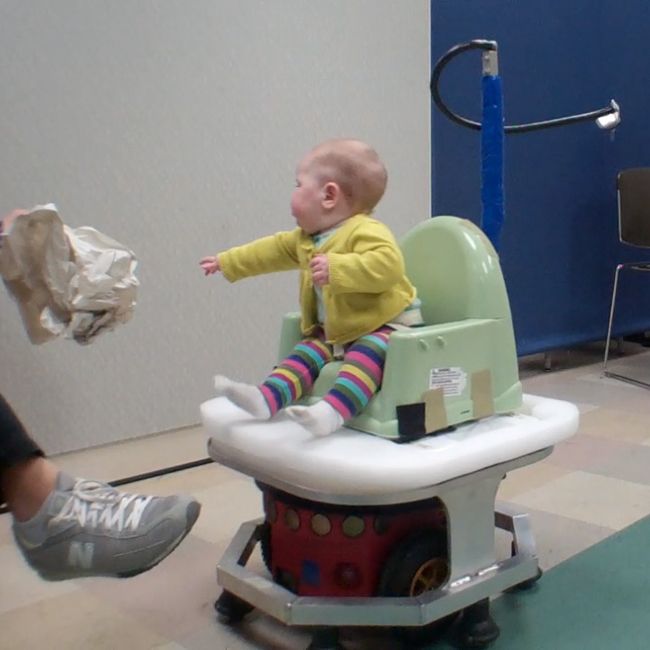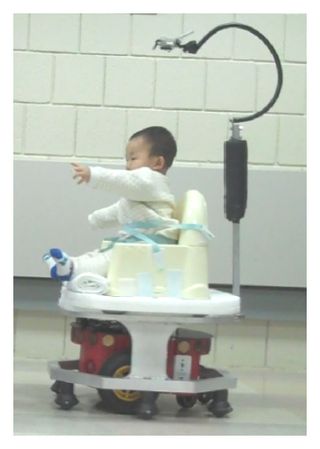How Baby-Driven Robots Could Help Disabled Children

A typical five-month-old infant has hardly figured out how to sit up yet — even crawling may be months away — but there are a few babies who already know how to drive. They're steering their very own mobile robots.
The robots are designed to allow babies with disabilities to move around independently, at the same age their peers might learn to crawl. Whether they use robots or their own limbs, starting to move may be an important part of baby brain development, some childhood specialists think. Researchers don't want kids with cerebral palsy or other movement disorders to miss out.
"We think that babies with disabilities are missing an opportunity for learning that typically developing babies have," said Carole Dennis, a professor occupational therapy at Ithaca College in New York.
Dennis and her colleagues published the latest study on baby-drivable robots last month, in the journal Physiotherapy. They put together their robot, which they call the WeeBot, from off-the-shelf parts. Babies drive the WeeBot by leaning forward, right or left.
Many previous baby-driven robots used joysticks as controllers, but the WeeBot's creators thought leaning might be easier to learn and help expand the use of robots to even younger children.
"What I think is exciting is that we're pushing the age envelope much and much younger," said Maria Jones, a professor of physical therapy at the University of Oklahoma who was not involved in the WeeBot research.
The WeeBot joins an entire field of research, focused on babies driving robots, that some researchers say is ready for market. [Top 7 Useful Robots You Can Buy Right Now]
Sign up for the Live Science daily newsletter now
Get the world’s most fascinating discoveries delivered straight to your inbox.
Driving for baby brains
Generations of past research on typically developing children has shown that baby brains undergo dramatic changes when kids start to move by themselves. Those who work with disabled babies think that by giving the babies the ability to move by themselves at the right time, parents and clinicians may help stimulate similar brain activity.
Disabled children don't usually get to move independently until they're 3 years old or even older, when they are able to learn to use a motorized wheelchair. By that time, however, they may have missed an important window in their development, not to speak of how frustrating and sad it must be to want to move, but be unable to say so or do anything about it.
"We know the brain is aching for exploration," said Cole Galloway, a physical therapist at the University of Delaware who has studied robots for disabled babies for several years. "If we treated a typically developing kid the way we treat these kids, it would be as if we put these kids in a closet or a cage until they can take adult commands."
Although there aren't yet studies to prove this idea, researchers think that there may be a special time when babies stand to gain the most from rolling, scooting, crawling and making other movements, Dennis said. It may work something like the window of opportunity does for language learning, which becomes much more difficult with age. [Robot Legs Mimic How Babies Walk]
Without robotic assistance, Jones told InnovationNewsDaily, "They may not learn as much as they could, potentially, or it may be slower to come."
Driving the WeeBot
To make the WeeBot, the Ithaca researchers put a Nintendo Wii Balance Board atop a programmable, rolling robot base. The Wii board detects shifts in weight, so the base will roll forward, left or right, depending on how the baby rider leans. Researchers added sonar instruments to the front and back of their WeeBot, which prevent the little driver from running into obstacles. Then they sat five- to nine-month-old, typically developing babies into the WeeBots, "training" them to drive by having their parents sit in front of them and offer them a toy.

After training, typically developing babies drove successfully in 90 percent of trials, Dennis and her colleagues found.
They then tried the WeeBot in three kids with different disabilities, with mixed results.
A baby with Down syndrome they tested wasn't able to sit upright and wasn't interested in objects, so researchers couldn't interest him in learning to drive.
The researchers modified their robot with a button panel for a 3-year-old child with cerebral palsy who couldn't sit upright independently, but the buttons required such precise control that the boy would overshoot or undershoot his turns, which he found frustrating.
The researchers did get a hit with a 15-month-old boy with cerebral palsy who was able to lean to drive. He "took to it like he'd been doing it all his life," Dennis said.
At the start of the study, the boy could sit, but couldn't crawl and was in physical therapy to learn the skill. Typically developing babies can usually crawl at 12 months and may take their first steps around that age. Two weeks after he started driving, the 15-month-old started to creep along on his stomach.
"We like to think that his experience of moving influenced his desire to move, but we have no way of saying for sure," Dennis said.
Their mixed results mean different kids will need different controls, depending on their disability, Dennis said. Commercially available motorized wheelchairs may be modified so that people can nod their heads, move their tongues or blow puffs of air to control the chair, depending on what's easiest for them. In the future, commercial baby bots should be similarly customizable, Jones said.
Time to bring baby bots home?
Technologies like the WeeBot need more research into how to manufacture them in a cost-effective way, said Dennis and one of her colleagues, Hélène Larin, another Ithaca College physical therapist. The WeeBot also needs more safety features, in addition to its sonar, to detect drops such as stairs, they said.
Researchers should also work on studies that directly show that early movement for disabled babies helps their cognitive development, Larin said.
Yet others think it's time for commercial companies to pick up the research that university scientists have done on baby bots. Both Jones and Galloway say some robotic models are "absolutely" ready for commercialization.
"There's some kind of extra sparkle in kids' eyes when you hook them up [with a robot]," Galloway said. He suggests researchers in his field push to try their robots in real homes and schools. "Take this device, go out into the real world with it."
This story was provided by InnovationNewsDaily, a sister site to LiveScience. You can follow InnovationNewsDaily staff writer Francie Diep on Twitter @franciediep. Follow InnovationNewsDaily on Twitter @News_Innovation, or on Facebook.













